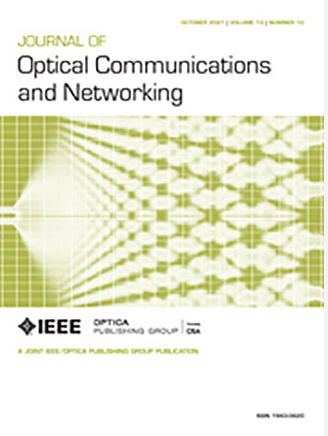Discrete-variable quantum key distribution services hosted in legacy passive optical networks [Invited]
IF 4
2区 计算机科学
Q1 COMPUTER SCIENCE, HARDWARE & ARCHITECTURE
引用次数: 0
Abstract
Fiber-based quantum key distribution (QKD) systems are mature and commercialized, but their integration into existing optical networks is crucial for their widespread use, in particular in passive optical networks (PONs) if end-to-end quantum-secured communications are to be addressed. While discrete-variable QKD coexistence with classical channels is well-studied in point-to-point links, its performance in point-to-multipoint topologies like PONs has received less attention. We thus developed a numerical tool to estimate quantum-available bandwidth and maximum link lengths for QKD systems in single-fiber PON architectures in coexistence with GPON, XG-PON, NG-PON2, and HS-PON standards. The QKD channel performance is obtained by setting thresholds on the quantum bit error rate and the secret key rate, ultimately limited by spontaneous Raman scattering noise and high optical distribution network losses. We perform a comparison between the performance obtained assuming the asymptotic infinite-key generation rate or taking into account actual implementations in the finite-key regime. We evidence that proper design rules can be obtained as a function of both classical and quantum system parameters to support end-to-end quantum security services in existing optical networks.传统无源光网络中的离散变量量子密钥分配服务[特邀]
基于光纤的量子密钥分配(QKD)系统已经成熟并商业化,但其集成到现有光网络中对于其广泛使用至关重要,特别是在无源光网络(pon)中,如果要解决端到端量子安全通信问题。虽然离散变量QKD与经典信道共存在点对点链路中得到了很好的研究,但它在点对多点拓扑(如PONs)中的表现却很少受到关注。因此,我们开发了一个数值工具来估计在GPON、XG-PON、NG-PON2和HS-PON共存的单光纤PON架构中QKD系统的量子可用带宽和最大链路长度。QKD信道性能是通过对量子误码率和密钥率设置阈值来获得的,最终受到自发拉曼散射噪声和高光分配网络损耗的限制。我们对假设渐近无限密钥生成率和考虑到有限密钥体系中的实际实现所获得的性能进行了比较。我们证明了适当的设计规则可以作为经典和量子系统参数的函数来获得,以支持现有光网络中的端到端量子安全服务。
本文章由计算机程序翻译,如有差异,请以英文原文为准。
求助全文
约1分钟内获得全文
求助全文
来源期刊
CiteScore
9.40
自引率
16.00%
发文量
104
审稿时长
4 months
期刊介绍:
The scope of the Journal includes advances in the state-of-the-art of optical networking science, technology, and engineering. Both theoretical contributions (including new techniques, concepts, analyses, and economic studies) and practical contributions (including optical networking experiments, prototypes, and new applications) are encouraged. Subareas of interest include the architecture and design of optical networks, optical network survivability and security, software-defined optical networking, elastic optical networks, data and control plane advances, network management related innovation, and optical access networks. Enabling technologies and their applications are suitable topics only if the results are shown to directly impact optical networking beyond simple point-to-point networks.

 求助内容:
求助内容: 应助结果提醒方式:
应助结果提醒方式:


